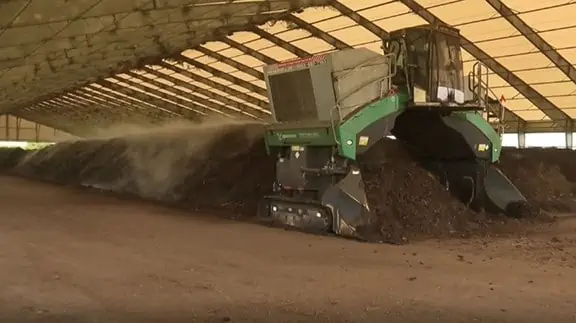

Biosolids Composting – Award Winning Facility in Hillsborough County – Environmental Category
The Planning Commission celebrated its 40th Annual Planning & Design Awards at a ceremony in late October. The event is in conjunction with a nationwide celebration of the American Planning Association’s National Community Planning Month.
The County Planning Commission recognized a joint effort between the County Board of County Commissioners, the Solid Waste Management Department, the County Water Resources Department, and SCS Engineers with its 2022 Excellence Award.
Hillsborough County combines tons of mulched yard cuttings and biosolids (treated wastewater residue) to create an in-demand soil amendment. Mixing, curing, and selling the product preserves disposal space at the Southeast Hillsborough County Landfill, saving taxpayers about $1.5 million in hauling, disposal, and other costs over five years. Selling the resulting soil supplement, meanwhile, adds new revenue.
Yard waste was traditionally burned to produce electricity or mixed with cover at the landfill. Treated wastewater by-products, known as biosolids, were trucked to the landfill for disposal, thus filling the landfill faster and, when combined with other organic matter creating greenhouse gases.
The plan to produce and sell compost results from a partnership between the County operations and SCS Engineers committed to finding a more efficient and environmentally friendly solution to reuse the two types of waste. The product meets stringent federal guidelines and regulations, providing a nutrient-rich material that safeguards consumers, crop production, and the environment.

Thanks to everyone who joined the celebration showcasing excellence in planning and design that contributes to the quality of life in Hillsborough County. If you’d like to learn more about this biosolids composting facility, please contact Kollan Spradlin or .
Communities across our nation are going greener, we suggest these educational resources:
Creosote is a toxic chemical that has been commonly used as a wood preservative for over 50 years. It acts as a pesticide, herbicide, and fungicide and has been used widely in both land and marine applications.

Studies have indicated that pilings and other artificial structures provide possible environmental benefits, such as habitat for invertebrates, roosts for birds, and a spawning location for certain fish species (e.g., herring). However, far more studies have indicated potential harm from treated structures. It is documented that pilings will leach the most during the first two years after installation after which leaching declines significantly.
The Norfolk Riverfront area has been developed since at least 1887, and the use of treated pilings can be presumed. The majorities of the pilings are presumed to
have been installed over two years ago and are therefore beyond the 2-year timeframe for significant leaching. Pilings that are shown to be in good condition and with a viable use as part of the development effort can remain in place with little effect on the surrounding environment.
This paper discusses the City of Norfolk’s waterfront brownfield redevelopment and the importance of understanding and developing an approach for the managed disposal of creosote pilings. The guidance is based on strategies approved by the U.S. Environmental Protection Agency and other noted expert sources such as waterfront municipalities, published white papers, and peer-reviewed publications.
Take me to the paper and information about the authors.

Other environmental groups are hard at work in the region. Lynnhaven River NOW, is one organization working with residents, businesses, and community leaders who are restoring and protecting Virginia Beach waterways.
Learn more here: http://www.lynnhavenrivernow.org/